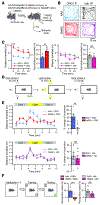Hyperactivity with Disrupted Attention by Activation of an Astrocyte Synaptogenic Cue
- PMID: 31031006
- PMCID: PMC6526045
- DOI: 10.1016/j.cell.2019.03.019
Hyperactivity with Disrupted Attention by Activation of an Astrocyte Synaptogenic Cue
Abstract
Hyperactivity and disturbances of attention are common behavioral disorders whose underlying cellular and neural circuit causes are not understood. We report the discovery that striatal astrocytes drive such phenotypes through a hitherto unknown synaptic mechanism. We found that striatal medium spiny neurons (MSNs) triggered astrocyte signaling via γ-aminobutyric acid B (GABAB) receptors. Selective chemogenetic activation of this pathway in striatal astrocytes in vivo resulted in acute behavioral hyperactivity and disrupted attention. Such responses also resulted in upregulation of the synaptogenic cue thrombospondin-1 (TSP1) in astrocytes, increased excitatory synapses, enhanced corticostriatal synaptic transmission, and increased MSN action potential firing in vivo. All of these changes were reversed by blocking TSP1 effects. Our data identify a form of bidirectional neuron-astrocyte communication and demonstrate that acute reactivation of a single latent astrocyte synaptogenic cue alters striatal circuits controlling behavior, revealing astrocytes and the TSP1 pathway as therapeutic targets in hyperactivity, attention deficit, and related psychiatric disorders.
Keywords: astrocyte; attention deficit; behavior; calcium; gabapentin; hyperactivity; microcircuit; striatum; thrombospondin.
Copyright © 2019 Elsevier Inc. All rights reserved.
Conflict of interest statement
Declaration of interests
The authors declare no commercial interests
Figures







Comment in
-
Star Power: Astrocytes Regulate Behavior.Cell. 2019 May 16;177(5):1091-1093. doi: 10.1016/j.cell.2019.04.042. Cell. 2019. PMID: 31100265
-
Star-like cells spark behavioural hyperactivity in mice.Nature. 2019 Jul;571(7763):43-44. doi: 10.1038/d41586-019-01949-2. Nature. 2019. PMID: 31263260 No abstract available.
-
Astroglial Ca2+ signals trigger pathological behaviour in optogenetic mouse.Cell Calcium. 2019 Sep;82:102062. doi: 10.1016/j.ceca.2019.102062. Epub 2019 Jul 27. Cell Calcium. 2019. PMID: 31374418 No abstract available.
References
-
- Adamsky A, Kol A, Kreisel T, Doron A, Ozeri-Engelhard N, Melcer T, Refaeli R, Horn H, Regev L, Groysman M, et al. (2018). Astrocytic Activation Generates De Novo Neuronal Potentiation and Memory Enhancement. Cell 174, 59–71. - PubMed
Publication types
MeSH terms
Substances
Grants and funding
LinkOut - more resources
Full Text Sources
Other Literature Sources
Medical
Molecular Biology Databases
Research Materials
Miscellaneous

